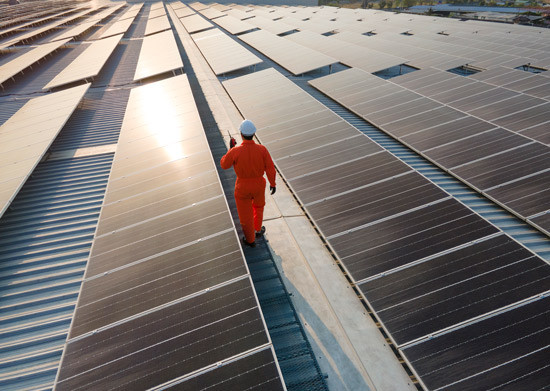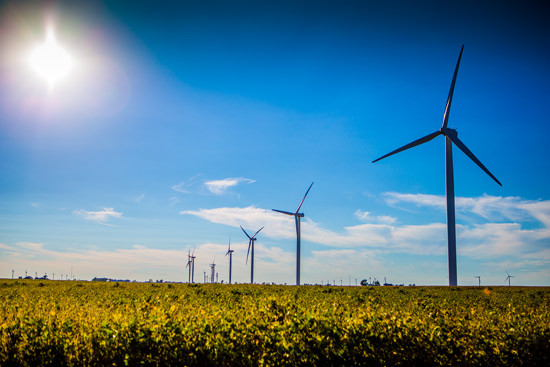Learning Center
Going Green: Insights Into Wind and Solar Project Taxation

As the world begins to embrace renewable energy sources to combat climate change, utility-scale wind and solar projects are growing at an incredible rate. These initiatives have become increasingly common in response to a variety of factors, such as a changing planet, federal tax incentives, and soaring demand. Consider the following statistics from the American Bar Association (ABA): In 2010, the United States had a total net capacity of 39,134.5 megawatts in utility-scale wind energy. By 2020, this number skyrocketed to 118,378.7 megawatts, marking a remarkable 200% increase in a mere decade. Similarly, the nation had only 393.4 megawatts of utility-scale solar energy capacity in 2010, but by 2020, that number rose to an astonishing 46,306.2 megawatts – an 11,600% increase.
As the wind and solar power industries continue to flourish, state and local tax authorities must determine how to deal with rapidly growing projects that have no precedents. This article delves into the current trends surrounding state and local taxation of utility-scale wind and solar work. We'll begin by offering a brief overview of the components that generally make up these types of projects, then summarize the various taxes that typically apply, including property tax and sales and use tax. As you continue reading, we'll highlight why developers in this field should be pay close attention to state and local tax issues.

I. Understanding Utility-Scale Wind and Solar Projects
Before we dive into the complexities of taxation, we’ll take a look at the basics of wind and solar projects. As with any subject, the fundamentals are essential.
Terminology: Wind and solar energy projects are often referred to by their "nameplate capacity," which indicates the maximum electricity output they can produce at full power, typically measured in megawatts. However, since most wind and solar projects don't operate at 100% capacity year-round, developers use a "capacity factor" – expressed as a percentage – to estimate their actual electricity production.
Components: Wind and solar projects are comprised of much more than just turbines and solar panels. They often sprawl across hundreds or thousands of acres and can require various components, including inverters, substations, underground cabling, maintenance facilities, transmission lines, and even battery storage systems. Most land-based wind and solar projects are constructed on vacant or active farmland.
As a result, a range of property tax and sales and use tax issues have arisen. Most notably, states must determine whether the property used for these projects should be classified as real or personal for tax purposes. This classification varies from state to state.

II. Current Taxation Trends
As wind and solar projects become more popular, different states have adopted their own tax regulations. Some current taxation trends are outlined below.
A. Property Taxes
Property taxes on these projects typically fall into one of three categories:
Value-Based (Ad Valorem) Tax: This type of taxation requires assessing the project's value and applying local tax rates. States often provide guidelines for valuing these projects accurately. For instance, the ABA notes that Michigan uses a depreciation factor to determine "true cash value."
Generation Tax: Some states impose a tax on the electricity generated by the project, utilizing a set rate per megawatt-hour produced. Minnesota, for instance, levies wind and solar energy production taxes.
Nameplate Capacity Tax: Certain states apply a predetermined rate to the project's nameplate capacity. In Nebraska, for example, wind and solar projects are taxed at a specific rate per megawatt of capacity.
Additionally, developers must consider how their states treat the land on which solar projects are constructed for property tax purposes, whether transmission-related taxes apply, and how battery energy storage systems are taxed.

B. Sales and Use Tax
Sales and use tax affects the entire lifecycle of wind and solar projects. During development, sales and use tax can significantly impact project expenses. Jurisdictions with high combined state and local tax rates can result in substantial expenses during this phase.
It is important to note, however, that many U.S. states offer specific tax exemptions for equipment and tangible personal property used in wind and solar projects. For example, the ABA points out that Iowa exempts "wind energy conversion property" and materials used for it, while Minnesota exempts "wind energy conversion systems" and "solar energy systems."
Although exemptions are available in a number of jurisdictions nationwide, it is still crucial for developers to consider sales and use tax when estimating project expenses, negotiating contracts, and planning for financing.
III. The Significance of State and Local Taxation
Understanding state and local taxation, and how it relates to clean energy projects, matters for several reasons:
Permits: Tax revenue, especially from property taxes, can significantly influence permitting decisions. Municipalities want assurance that developers will be responsible corporate citizens, and knowledge of tax revenue distribution plays a role in the permit process in most areas.
Education and Outreach: Developers must educate local governments and assessors about how projects will be taxed and revenue distributed.
Repowering and Equipment Replacement: As projects age, repowering or replacing equipment may trigger additional taxes. Developers must account for these factors in long-term planning.
Profit Maximization: Accurate expense estimation is essential for maximizing profits, making state and local taxes a vital consideration throughout a project's lifespan. In Indiana, for example, the region of the state in which a project is built can hugely impact property taxes. The Purdue Extension website notes that the state’s assessment formula values farmland at $1,500 per acre for taxes in 2023. The “solar base rate” is also set by the state, varying widely from $5,400 to $13,000 per acre depending on location.
As the wind and solar industry continues to rapidly expand, state and local taxation issues will only become more important. Developers must navigate tax issues in order to determine where they want to launch new clean energy construction – some states are more affordable than others for these types of projects.
NEVER MISS A STORY.
Sign up for our newsletters and get our articles delivered right to your inbox.
Rose Tax & Financial
Cedar Crest, New Mexico 87008
Sat: 10:00am to 2:00pm
Check the background of your financial professional on FINRA's BrokerCheck
Avantax affiliated Financial Professionals may only conduct business with residents of the states for which they are properly registered. Please note that not all of the investments and services mentioned are available in every state. Securities offered through Avantax Investment Services℠, Member FINRA, SIPC, Investment Advisory services offered through Avantax Advisory ServicesSM, Insurance services offered through an Avantax affiliated insurance agency. 3200 Olympus Blvd., Suite 100, Dallas, TX 75019. 972-870-6000.
The Avantax family of companies exclusively provide financial products and services through its financial representatives. Although Avantax Wealth Management® does not provide or supervise tax or accounting services, Avantax representatives may offer these services through their independent outside business. Content, links, and some material within this website may have been created by a third party for use by an Avantax affiliated representative. This content is for educational and informational purposes only and does not represent the views and opinions of Avantax Wealth Management® or its subsidiaries. Avantax Wealth Management® is not responsible for and does not control, adopt, or endorse any content contained on any third party website.
This information is not intended as tax or legal advice. Please consult legal or tax professionals for specific information regarding your individual situation.
The information being provided is strictly as a courtesy. When you link to any of the web sites provided here, you are leaving this web site. We make no representation as to the completeness or accuracy of information provided at these web sites. Nor is the company liable for any direct or indirect technical or system issues or any consequences.
For Important Information and Form CRS please visit https://www.avantax.com/disclosures.